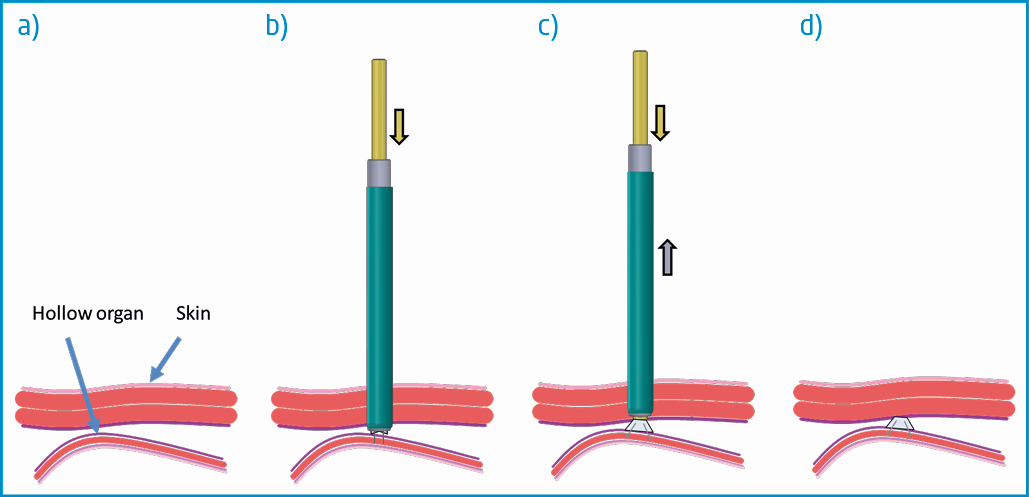Dans la même rubrique
-
Partager cette page
Minimally invasive anchoring system [Offre de technologie]
The technology in a nutshell
New minimally invasive anchoring system implantable onto hollow organ and offering versatile applications.
State of the art
In last decades, the development of laparoscopic instruments has highly reduced the variability and the potential difficulties in exposure and suturing during the surgical interventions accessing the abdominal cavity. Nowadays, novel techniques are focusing on further reducing the procedure invasiveness by reducing the access size and using single port techniques. However, there is still a lack of tools capable of suturing or anchoring a device onto hollow organs (e.g. stomach, bladder, oesophagus, small intestine, large intestine, etc.) with such a single hole access, in an easy and mini-invasive way.
The invention
The invention provides methods and tools to implant a durable anchoring system with a single access percutaneous surgery with a low invasive procedure. An anchor, made of a flexible body composed of silicone rubber, and two or more holding pins, is designed to be attached on any hollow organs with a single incision procedure to minimise the duration of the procedure, the risks for the patient and the resulting scar, which is almost invisible.
This anchoring system can be used for various applications, from single step stapling to mini-invasive placement of stimulation electrodes in soft tissue. Indeed, it has the advantage of being mainly made of flexible silicone, easily reshapable when manufactured, and able to comprise two or more electrodes (for sensing and/or stimulation), drugs delivery channels or to offer an efficient surgical closure.

Overview of major implantation steps (simplified).
Potential application
- Electrostimulation implants
- Implantable medical sensor
- Implantable drug delivery systems
- Surgical closure
Key advantage of the technology
- Mini-invasive and single step anchoring technique, reducing surgery duration, scar visibility and risk for the patient.
- Wide variety of application from electrode anchoring to drug delivery, or stapling.
- Highly versatile thanks to its silicone base reshapable for any needs, able to embed two or more holding pins that can be used for sensing and/or functional stimulation.
Technology Readiness Level

When attached on the stomach for functional stimulation, it was proven to hold more than one year during a pre-clinical study on 6 dogs. The flexibility and the shape of the main silicone body can be easily redesigned to match the targeted application and location.
The inventors
Adrien Debelle holds a MSc degree in Electromechanical engineering from the Université Libre de Bruxelles (2014). His research as a PhD student in the BEAMS department focuses on mini-invasive surgery to implant a gastric stimulation device to counter obesity.
The laboratory
The multidisciplinary nature of the BEAMS (Bio Electro and Mechanical Systems) department enables us to deal with biomedical engineering problems involving microtechnics, mechanics, electromechanics, electrical engineering, electronics, and human organ modelling. The major interest of the biomedical group in BEAMS is to develop medical devices in collaboration with doctors. BEAMS has developed close relation with many medical departments in Europe.
The research axes of BEAMS in the biomedical field are the following:
- Flexible mechanics, including design of medical devices for therapeutic endoscopy, force feedback system and size measurement device for endoscopic applications, real time in vivo biosensor, controllable stiffness mechanism for endoscopic and catheter applications.
- Bioelectronics, including design of gastric micro-invasive implantable stimulator, implant design and manufacturing – implantable optoelectronics, medical monitoring devices – 3D ballistocardiography, modelling of biomedical and electrical behaviour and signal processing.
- Biomechanics, including experimental and finite element analysis of human joints, orthopaedic implants design and analysis, mechanical characterisation of soft tissues, patient specific modelling.
Keywords
- Mini-invasive anchoring
- Suturing
- Stapling
- Electrical stimulation
- Percutaneous implantation
- Single incision laparoscopy
- Soft tissue
Collaboration type
- Licence agreement
- R&D collaboration
IP status
- Priority application: EP18213753 – 18/12/2018
- Patent: 12,133,986 (US)
Inventors
- Antoine NONCLERCQ
- Adrien DEBELLE
Contact
ULB Research Department
Arnaud Quintens
Business developer
+32 (0)2 650 96 78
arnaud.quintens@ulb.be
